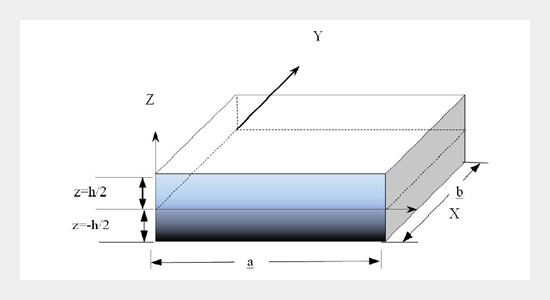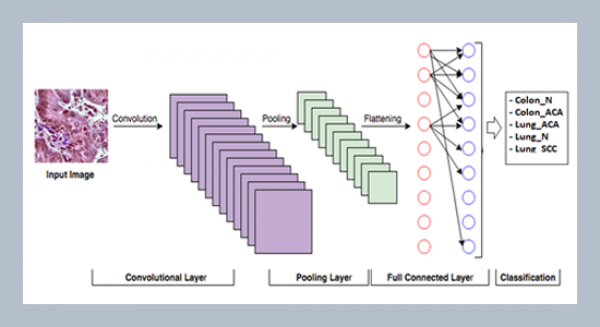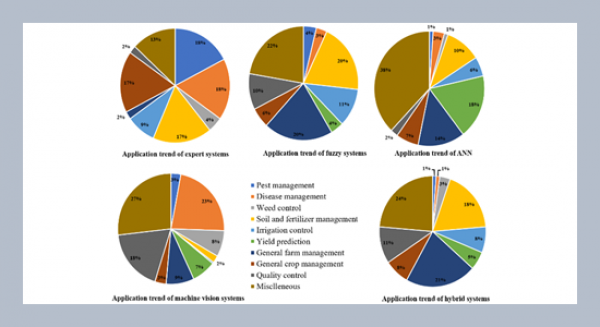B. Sidda Redddya*, J. Suresh Kumarb, C. Eswara Reddyc, and K. Vijaya Kumar Reddyb aSchool of Mechanical Engineering, R. G. M. College of Engineering and Technology, Nandyal, Kurnool (Dt), Andhra Pradesh, India
bDepartment of Mechaical Engineering, J. N. T. U. H. College of Engineering, J. N. T. University, Hyderabad, India
cSchool of Engineering & Technology, Sri Padmavathi Mahila Visvavidyalayam, Women’s University, Tirupati, Chittoor, Andhra Pradesh, India
Download Citation:
|
Download PDF
This paper presents analytical formulations and solutions for the static analysis of functionally graded plates (FGPs) using higher order shear deformation theory (HSDT) without enforcing zero transverse shear stress on the top and bottom surfaces of the plate. The theoretical model presented herein incorporates the transverse extensibility which accounts for the transverse effects. The equations of equilibrium and boundary conditions are derived using the principle of virtual work. Solutions are obtained for FGPs in closed-form using Navier’s technique. The results are compared with the other HSDTs for deflections and stresses. It can be concluded that the proposed theory is accurate and efficient in predicting the static responses of functionally graded plates. The results show that, the effect of transverse shear deformation is quite significant at side-to-thickness ratio less than 10 on maximum center deflections and stresses and the response of FGPs is intermediate to that of ceramic and metal plates. ABSTRACT
Keywords:
Static analysis; functionally graded plates; HSDT; Navier’s method.
Share this article with your colleagues
[1] Reddy, J. N. 2000. Analysis of functionally graded plates. International Journal for Numerical Methods in Engineering, 47: 663-684.REFERENCES
[2] Reddy, J. N. and Chin, C. D. 1998. Thermomechanical analysis of functionally graded cylinders and plates. Journal of Thermal Stresses, 21, 6: 593-626.
[3] Vel, S. S. and Batra, R. C. 2002. Exact solutions for thermoelastic deformations of functionally graded thick rectangular plates. AIAA Journal, 40: 1421-1433.
[4] Vel, S. S. and Batra, R. 2003. Three dimensional analysis of transient thermal stresses in functionally graded plates. International Journal of Solids and Structures, 40, 25: 7181-7196.
[5] Cheng, Z. Q. and Batra, R. C. 2000. Three dimensional thermoelastic deformations of a functionally graded-eliptic plate. Composites: Part B, 31: 97-106.
[6] Javaheri, R. and Eslami, Mr. 2002. Thermal buckling of functionally graded plates based on higher order shear deformation theory. Journal of Thermal Stresses, 25, 7: 603-625.
[7] Reissner, E. 1945. The effect of transverse shear deformation on the bending of elastic plates. Journal of Applied Mechanics: ASME, 12, 2: 69-77.
[8] Mindlin, R. D. 1951. Influence of rotary inertia and shear on flexural motions of isotropic, elastic plates. Journal of Applied Mechanics: ASME, 18: 31-38.
[9] Thai, H. T. and Thuc, P. Vo. 2013. A new sinusoidal shear deformation theory for bending, buckling, and vibration of functionally graded paltes. Applied Mathematical Modelling, 37: 3269-3281.
[10] Zenkour, A. M. 2005. A comprehensive analysis of functionally graded sandwich plates: Part-1-Deflection and stresses. International Journal of Solids and Structures, 42, 18-19: 5224-5242.
[11] Zenkour, A. M. 2005. A comprehensive analysis of functionally graded sandwich plates: Part-2-Buckling and free vibration. International Journal of Solids and Structures, 42, 18-19: 5243-5258.
[12] Zenkour, A. M. 2006. Generalized shear deformation theory for bending analysis of functionally graded plates. Applied Mathematical Modelling, 30, 1: 67-84.
[13] Kant, T., Owen, D. R. J., and Zienkiewicz, O. C. 1982. A refined higher order C0 plate element. omputers & Structures, 15, 2: 177-183.
[14] Pandya, B. N. and Kant, T. 1988. Higher-order shear deformable theories for flexure of sandwich plates-finite element evaluations. International Journal of Solids and Structures, 24, 12: 1267-1286.
[15] Pandya, B. N. and Kant, T. 1988. Finite element analysis of laminated composite plates using a higher order displacement model. Composites Science and Technology, 32, 2: 137-155.
[16] Kant, T. and Swaminathan, K. 2002. Analytical solutions for the static analysis of laminated composite and sandwich plates based on higher order refined theory. Composite Structures, 56, 4: 329-344.
[17] Kant, T. and Swaminathan, K. 2001. Analytical solutions for free vibration analysis of laminated composite and sandwich plates based on higher order refined theory. Composite Structures, 53, 1: 73-85.
[18] Garg, A. K., Khare, R. K., and Kant, T. 2006. Higher order closed form solutions for free vibration of laminated composite and sandwich shells. Journal of Sandwich Structures and Materials, 8, 3: 205-235.
[19] Golmakani, M. E. and Kadkhodayan, M. 2011. Nonlinear bending analysis of annular FGM plates using higher order shear deformation plate theories. Composite Structures, 93: 973-982.
[20] Matsunaga, H. 2008. Free vibration and stability of functionally graded plates according to a 2-D higher-order deformation theory. Composite Structures, 82: 499-512.
[21] Matsunaga, H. 2009. Stress analysis of functionally graded plates subjected to thermal and mechanical loadings. Composite Structures, 87: 344-357.
[22] Xiang, S. and Kang, G. W. 2013. A nth-order shear deformation theory for the bending analysis on the functionally graded plates. European Journal of Mechanics-A/Solids, 37 : 336-343.
[23] Neves, A. M. A., Ferreira, A. J. M., Carrera, E., Cinefra, M., Roque, C. M. C., Jorge, R. M. N., and Soares, C. M. M. 2013. Free vibration analysis of functionally graded shells by a higher-order shear deformation theory and radial basis functions collocation, accounting for through-the-thickness deformations. European Journal of Mechanics-A/Solids, 37: 24-34.
[24] Neves, A. M. A., Ferreira, A. J. M., Carrera, E., Cinefra, M., Roque, C. M. C., Jorge, R. M. N., and Soares, C. M. M. 2013. Static, free vibration and buckling analysis of isotropic and sandwich functionally graded plates using a quasi-3D higher-order shear deformation theory and meshless technique. Composites: Part B, 44: 657-674.
[25] Mechab, I., Atmane, H. A., Tounsi, A., Belhadej, H. A., and Bedia, E. A. A. 2010. A two variable refined plate theory for the bending analysis of functionally graded plates. Acta Mechanica Sinica, 26: 941-949.
[26] Mantari, J. L. and Guedes Soares, C. 2013. A novel higher-order shear deformation theory with stretching effect for functionally graded plates. Composites: Part B, 45: 268-281.
[27] Kant, T. and Manjunatha, B. S. 1988. An unsymmetric FRC laminate C0 finite element model with 12 derees of freedom per node. Engineering with Computers, 5, 3: 300-308.
[28] Carrera, E., Brischetto, S., Cinefra, M., and Soave, M. 2011. Effects of thickness stretching in functionally graded plates and shells. Composites Part B: Engineering, 42: 123-133.
[29] Carrera, E., Brischetto, S., and Robaldo, A. 2008. Variable kinematic model for the analysis of functionally graded material plates. AIAA Journal, 46: 194-203.
[30] Neves, A. M. A., Ferreira, A. J. M., Carrera, E., Cinefra, M., Roque, C. M. C., and Jorge, R. M. N. 2012. A quasi-3d sinusoidal shear deformation theory for the static and free vibration analysis of functionally graded plates. Composites Part B: Engineering, 43: 711-725.
ARTICLE INFORMATION
Received:
2013-04-18
Revised:
2013-10-10
Accepted:
2013-10-30
Available Online:
2014-03-01
Redddy, B.S., Kumar, J.S., Reddy, C.E., Reddy, K.V.K. 2014. Static analysis of functionally graded plates using Higher-Order shear deformation theory. International Journal of Applied Science and Engineering, 12, 23–41. https://doi.org/10.6703/IJASE.2014.12(1).23
Cite this article:















